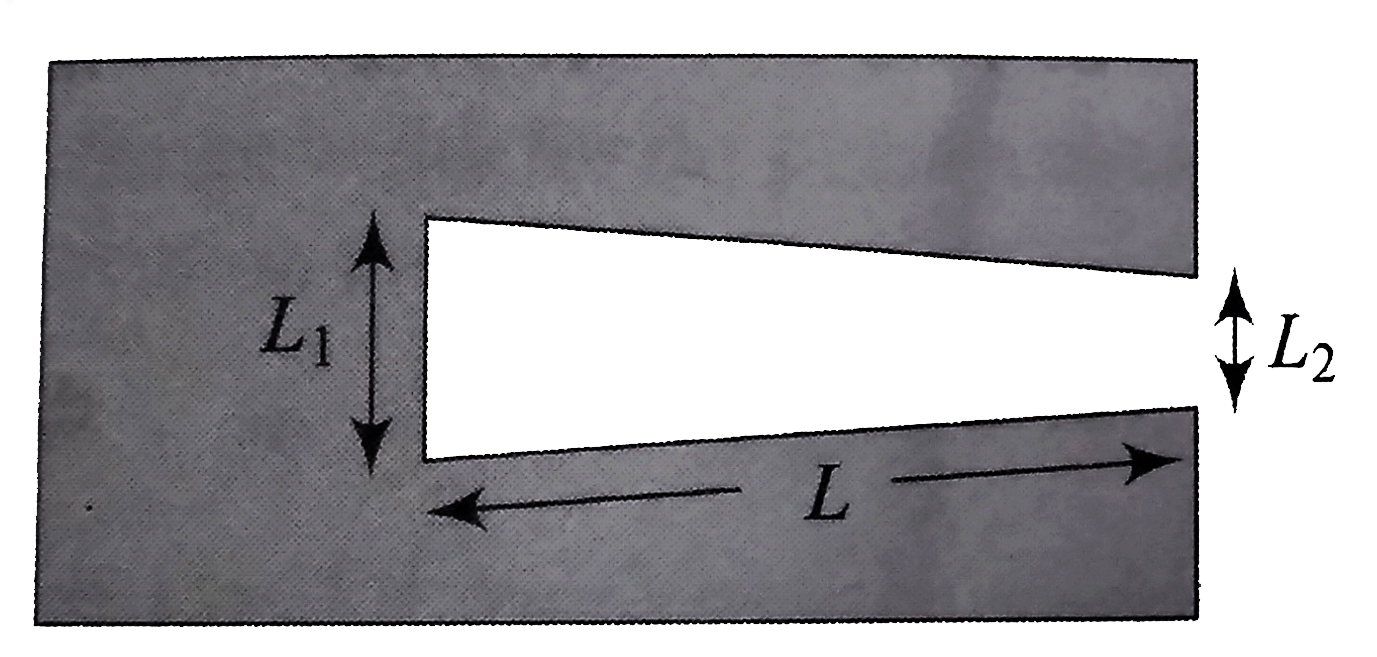
In Figure, two microscope slides touch at one end and are separated at the other end. When light of wavelength 420 nm shines vertically down on the slides, an overhead observer sees an interference pattern on the slides with the dark fringes separated by 1.9 mm. What is the angle between the slides?
0.0063∘
Topper's Solved these Questions
- INTERFERENCE AND DIFFRACTION BOOK - RESNICK AND HALLIDAYCHAPTER - INTERFERENCE AND DIFFRACTION EXERCISE - PRACTICE QUESTIONS (Single Correct Choice Type)
66 Videos
- INTERFERENCE AND DIFFRACTION BOOK - RESNICK AND HALLIDAYCHAPTER - INTERFERENCE AND DIFFRACTION EXERCISE - PRACTICE QUESTIONS (More than One Correct Choice Type)
23 Videos
- INTERFERENCE AND DIFFRACTION BOOK - RESNICK AND HALLIDAYCHAPTER - INTERFERENCE AND DIFFRACTION EXERCISE - CHECKPOINT
6 Videos
- HYDROGEN ATOMBOOK - RESNICK AND HALLIDAYCHAPTER - HYDROGEN ATOMEXERCISE - PRACTICE QUESTIONS(Integer Type)
6 Videos
- MAGNETIC FIELDS DUE TO CURRENTSBOOK - RESNICK AND HALLIDAYCHAPTER - MAGNETIC FIELDS DUE TO CURRENTSEXERCISE - Practice Question (Integer Type)
4 Videos
Similar Questions
Young’s double slit experiment is performed with light of wavelength 550 nm . The separation between the slits is 1.10mm and screen is placed at distance of 1 m . What is the distance between the consecutive bright or dark fringes
View SolutionTwo slits separated by a distance of 1 mm are illuminated with red light of wavelength 6.5×10−7m. The interference firnges are observed on a screen placed 1 m form the slits. The distance between third bright firnge and the fifth dark fringe on the same side is equal to
View Solution
Knowledge Check
Monochromatic green light of wavelength 500 nm illuminates a pair of slits 1 mm apart. Separation between the two consecutive bright fringes on the interference pattern formed on a screen 2 m away is
A0.25mmB0.1mmC1.0mmD0.01mmYoung’s double slit experiment is performed with light of wavelength 550 nm . The separation between the slits is 1.10mm and screen is placed at distance of 1 m . What is the distance between the consecutive bright or dark fringes
A1.5mmB1.0mmC0.5mmDNone of theseTwo slits separated by a distance of 1 mm are illuminated with red light of wavelength 6.5×10−7m. The interference firnges are observed on a screen placed 1 m form the slits. The distance between third bright firnge and the fifth dark fringe on the same side is equal to
A9.75 mmB0.975 mmC9.75 μmD19.5 mm
In Young's double-slit experiment,, monochromatic light of wavelength 630 nm illuminates the pair of slits and produces an interference pattern in which two consecutive bright fringes are separated by 8.1mm. Another source of monochromatic light produces the interference pattern in which the two consecutive bright fringes are separated by7.2 mm. find the wavelength of light from the second source.
What is the effect on the interference fringes if the monochromatic source is replaced by a source of white light ?
View SolutionIn Young's double-slit experiment, monochromatic light of wavelength 630 nm illuminates the pair of slits prodcues an interference pattern in which two consecutive bright fringes are separated by 8.1 mm. Another source of monochromatic light produces the interference pattern in which the two consecutive bright fringes are separated by 7.2 mm. Find the wavelength of light for the second source.
What is the effect on the interference fringes if the monochromatic source is replaced by a source of white light?
View SolutionA block o plastic having a thin air cavity (whose thickenss is comparable to wavelength of light waves) is shown in fig. The thickness of air cavity (which can be considered as air wedge for interference pattern) is varying linearly from one end to other as shown.
A broad beam of monochromatic light is incident normally from the top of the plastic box. Some ligth lis reflected back above and below the cavity .The plastic layers than wavelength of incident light . An observer when looking down from top sees an interference pattern consisting of eight dark fringes and seven bright fringe along the wedge. Take wavelength of incident light in air as λ0 and refractive index of plastic as μ
Assume that the thickness of the ends of air cavity are such that formation of fringe takes place there.

Determine the separation between 1st and 2nd dark fringes form the left end of air cavity
View SolutionOne microscope slide is placed on top of another with their left edges in contact and a human hair under the right edge of the upper slide. As a result, a wedge of air exists between the slides. An interference pattern results when monochromatic light is incident on the wedge.
View SolutionA block o plastic having a thin air cavity (whose thickenss is comparable to wavelength of light waves) is shown in fig. The thickness of air cavity (which can be considered as air wedge for interference pattern) is varying linearly from one end to other as shown.
A broad beam of monochromatic light is incident normally from the top of the plastic box. Some ligth lis reflected back above and below the cavity .The plastic layers than wavelength of incident light . An observer when looking down from top sees an interference pattern consisting of eight dark fringes and seven bright fringe along the wedge. Take wavelength of incident light in air as λ0 and refractive index of plastic as μ
Assume that the thickness of the ends of air cavity are such that formation of fringe takes place there.

Determine the separation between 1st and 2nd dark fringes form the left end of air cavity
View Solution
